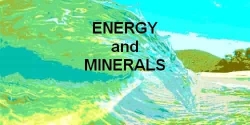Metamorphic Petrology
Metamorphic Petrology
source http://www.sandatlas.org/what-do-you-mean-hydrothermal/
http://www.tulane.edu/~sanelson/eens212/typesmetamorph.htm
Types of
Metamorphism
Classification
of Metamorphic Rocks
Facies
Textures
Minerals /
Reactions
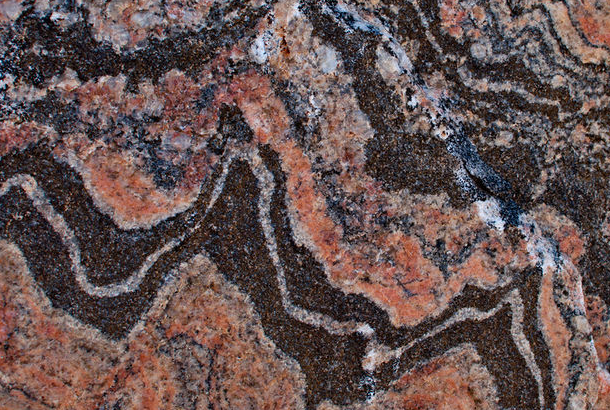
Definition of Metamorphism
The mineralogical and structural adjustment of solid rocks to physical and chemical conditions that have been imposed at depths below the near surface zones of weathering and diagenesis and which differ from conditions under which the rocks in question originated.
Metamorphic rocks can be derived from sedimentary, igneous or other metamorphic rocks from heat and pressure in which the rock remains in a solid state (melting would create and igneous rock)
In general terms metamorphic rocks are characterised by an increase in both crystal size and density though there are some exceptions.
Grade of Metamorphism
As the temperature and/or pressure increases on a body of rock we say the rock undergoes prograde metamorphism or that the grade of metamorphism increases. Metamorphic grade is a general term for describing the relative temperature and pressure conditions under which metamorphic rocks form.
Low-grade metamorphism takes place at
temperatures between about 200 to 320oC, and relatively low
pressure. Low grade metamorphic rocks are generally characterized
by an abundance of hydrous minerals. With incasing
grade of metamorphism, the hydrous minerals begin to react with other
minerals and/or break down to less hydrous minerals.
High-grade metamorphism takes place at temperatures greater than
320oC and relatively high pressure. As grade of
metamorphism increases, hydrous minerals become less hydrous, by losing
H2O, and non-hydrous minerals become more common.
Types of Metamorphism
Contact MetamorphismContact metamorphism occurs adjacent to igneous intrusions and results from high temperatures associated with the igneous intrusion
Since only a small area surrounding the intrusion is heated by the magma, metamorphism is restricted to the zone surrounding the intrusion, called a metamorphic or contact aureole Outside of the contact aureole, the rocks are not affected by the intrusive event.The grade of metamorphism increases in all directions toward the intrusion. Because temperature differences between the surrounding rock and the intruded magma are larger at shallow levels in the crust where pressure is low, contact metamorphism is often referred to as high temperature, low pressure metamorphism.The rock produced is often a fine-grained rock that shows no foliation, called a hornfels.
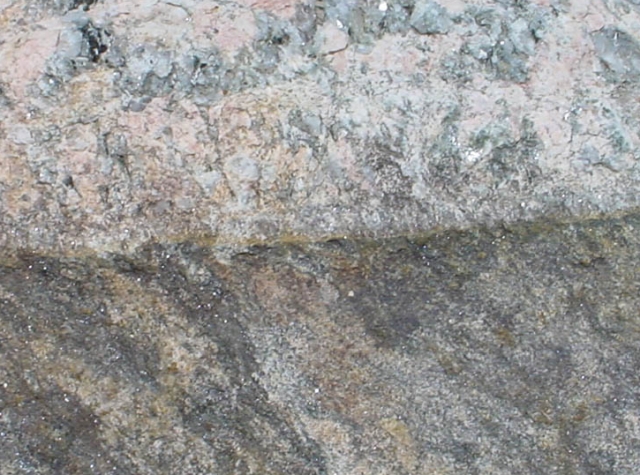
Regional metamorphism
Regional metamorphism occurs over large areas and generally does not show any relationship to igneous bodies. Most regional metamorphism is accompanied by deformation under non-hydrostatic or differential stress conditions.Thus, regional metamorphism usually results in forming metamorphic rocks that are strongly foliated, such as slates, schists, and gniesses.The differential stress usually results from tectonic forces that produce compressional stresses in the rocks, such as when two continental masses collide. Thus, regionally metamorphosed rocks occur in the cores of fold/thrust mountain belts or in eroded mountain ranges. Compressive stresses result in folding of rock and thickening of the crust, which tends to push rocks to deeper levels where they are subjected to higher temperatures and pressures.
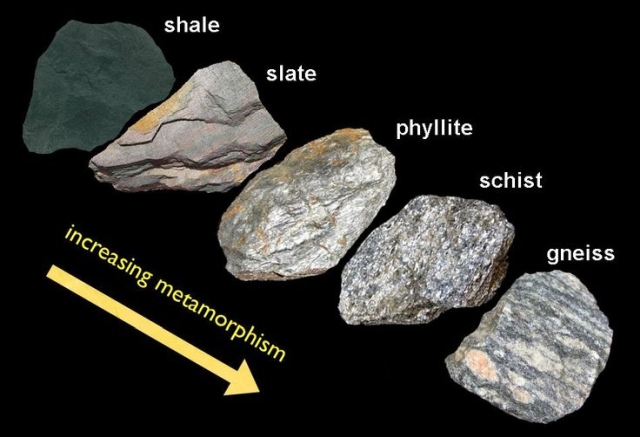
Cataclastic Metamorphism
Cataclastic metamorphism occurs as a result of mechanical deformation, like when two bodies of rock slide past one another along a fault zone. Heat is generated by the friction of sliding along such a shear zone, and the rocks tend to be mechanically deformed, being crushed and pulverized, due to the shearing. Cataclastic metamorphism is not very common and is restricted to a narrow zone along which the shearing occurred.
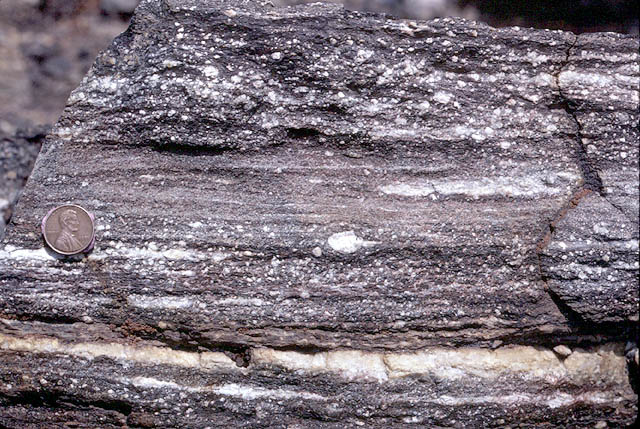
Hydrothermal Metamorphism
Rocks that are altered at high temperatures and moderate pressures by hydrothermal fluids are hydrothermally metamorphosed. This is common in basaltic rocks that generally lack hydrous minerals. The hydrothermal metamorphism results in alteration to such Mg-Fe rich hydrous minerals as talc, chlorite, serpentine, actinolite, tremolite, zeolites, and clay minerals.
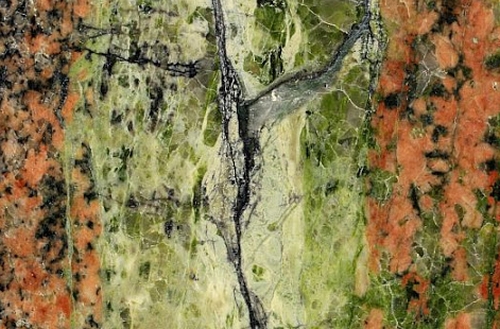
Burial Metamorphism
When sedimentary rocks are buried to depths of several hundred meters, temperatures greater than 300oC may develop in the absence of differential stress. New minerals grow, but the rock does not appear to be metamorphosed. The main minerals produced are the Zeolites. Burial metamorphism overlaps, to some extent, with diagenesis, and grades into regional metamorphism as temperature and pressure increase.
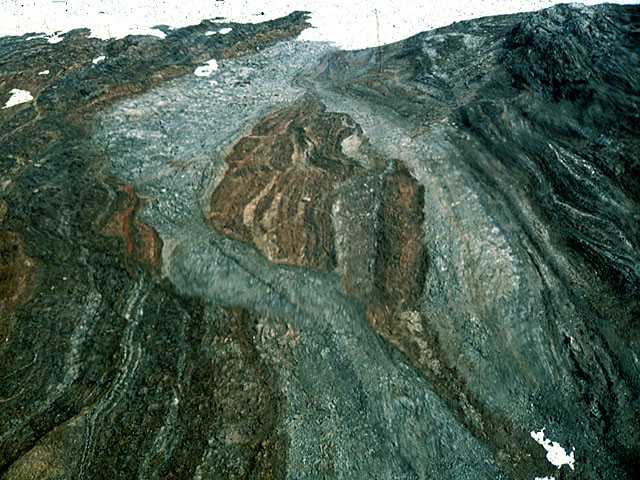
Shock Metamorphism (Impact Metamorphism)
When an extraterrestrial body, such as a meteorite or comet impacts with the Earth or if there is a very large volcanic explosion, ultrahigh pressures can be generated in the impacted rock. These ultrahigh pressures can produce minerals that are only stable at very high pressure, such as the SiO2 polymorphs coesite and stishovite. In addition they can produce textures known as shock lamellae in mineral grains, and such textures as shatter cones in the impacted rock.
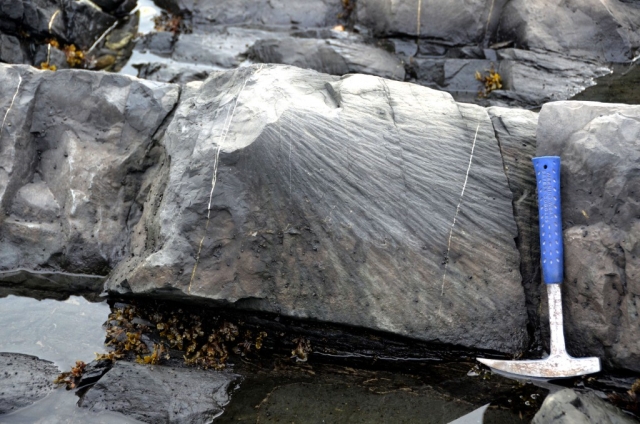
Classification of Metamorphic Rocks
Mineral assemblage, texture, protolith, and bulk chemical composition of the rock.Texture
In metamorphic rocks individual minerals may or may not be bounded by crystal faces. Those that are bounded by their own crystal faces are termed idioblastic. Those that show none of their own crystal faces are termed xenoblastic. From examination of metamorphic rocks, it has been found that metamorphic minerals can be listed in a generalized sequence, known as the crystalloblastic series, listing minerals in order of their tendency to be idioblastic. In the series, each mineral tends to develop idioblastic surfaces against any mineral that occurs lower in the series. This series is listed below:
- rutile, sphene, magnetite
- tourmaline kyanite, staurolite, garnet, andalusite
- epidote, zoisite, lawsonite, forsterite
- pyroxenes, amphiboles, wollastonite
- micas, chlorites, talc, stilpnomelane, prehnite
- dolomite, calcite
- scapolite, cordierite, feldspars
- quartz
Another aspect of the crystalloblastic series is that minerals high on the list tend to form porphyroblasts (the metamorphic equivalent of phenocrysts), although K-feldspar (a minerals that occur lower in the list) may also form porphyroblasts. Porphyroblasts are often riddled with inclusions of other minerals that were enveloped during growth of the porphyroblast. These are said to have a poikioblastic texture.
Most metamorphic textures involve foliation. Foliation is generally caused by a preferred orientation of sheet silicates. If a rock has a slatey cleavage as its foliation, it is termed a slate, if it has a phyllitic foliation, it is termed a phyllite, if it has a shistose foliation, it is termed a schist. A rock that shows a banded texture without a distinct foliation is termed a gneiss. All of these could be porphyroblastic (i.e. could contain porhyroblasts).
A rock that shows no foliation is called a hornfels if the grain size is small, and a granulite, if the grain size is large and individual minerals can be easily distinguished with a hand lens.
Protolith
Protolith refers to the original rock, prior to metamorphism. In low grade metamorphic rocks, original textures are often preserved allowing one to determine the likely protolith. As the grade of metamorphism increases, original textures are replaced with metamorphic textures and other clues, such as bulk chemical composition of the rock, are used to determine the protolith.
Bulk Chemical Composition
The mineral assemblage that develops in a metamorphic rock is dependent on
- The pressure and temperature reached during metamorphism
- The composition of any fluid phase present during metamorphism, and
- The bulk chemical composition of the rock.
- Pelitic
These rocks are derivatives of aluminous sedimentary rocks like shales and mudrocks. Because of their high concentrations of alumina they are recognized by an abundance of aluminous minerals, like clay minerals, micas, kyanite, sillimanite, andalusite, and garnet.
- Quartzo-Feldspathic
Rocks that originally contained mostly quartz and feldspar like granitic rocks and arkosic sandstones will also contain an abundance of quartz and feldspar as metamorphic rocks, since these minerals are stable of a wide range of temperature and pressure. Those that exhibit mostly quartz and feldspar with only minor amounts of aluminous minerals are termed quartzo-feldspathic.
- Calcareous
Calcareous rocks are calcium rich. They are usually derivatives of carbonate rocks, although they contain other minerals that result from reaction of the carbonates with associated siliceous detrital minerals that were present in the rock. At low grades of metamorphism calcareous rocks are recognized by their abundance of carbonate minerals like calcite and dolomite. With increasing grade of metamorphism these are replaced by minerals like brucite, phlogopite (Mg-rich biotite), chlorite, and tremolite. At even higher grades anhydrous minerals like diopside, forsterite, wollastonite, grossularite, and calcic plagioclase.
- Basic
Just like in igneous rocks, the general term basic refers to low silica content. Basic metamorphic rocks are generally derivatives of basic igneous rocks like basalts and gabbros. They have an abundance of Fe-Mg minerals like biotite, chlorite, and hornblende, as well as calcic minerals like plagioclase and epidote.
- Magnesian
Rocks that are rich in Mg with relatively less Fe, are termed magnesian. Such rocks would contain Mg-rich minerals like serpentine, brucite, talc, dolomite, and tremolite. In general, such rocks usually have an ultrabasic protolith, like peridotite, dunite, or pyroxenite.
- Ferriginous
Rocks that are rich in Fe with little Mg are termed ferriginous. Such rocks could be derivatives of Fe-rich cherts or ironstones. They are characterized by an abundance of Fe-rich minerals like greenalite (Fe-rich serpentine), minnesotaite (Fe-rich talc), ferroactinolite, ferrocummingtonite, hematite, and magnetite at low grades, and ferrosilite, fayalite, ferrohedenbergite, and almandine garnet at higher grades.
- Manganiferrous
Rocks that are characterized by the presence of Mn-rich minerals are termed manganiferrous. They are characterized by such minerals as Stilpnomelane and spessartine.
Note that classification is generally loose and practical such that names can be adapted to describe the rock in the most satisfactory way that conveys the important characteristics.
Three kinds of criteria are normally employed. These are:
- Mineralogical - The most distinguishing minerals are used as a prefix to a textural term. Thus, a schist containing biotite, garnet, quartz, and feldspar, would be called a biotite-garnet schist. A gneiss containing hornblende, pyroxene, quartz, and feldspar would be called a hornblende-pyroxene gneiss. A schist containing porphyroblasts of K-feldspar would be called a K-spar porphyroblastic schist.
- Chemical - If the general chemical composition can be
determined from the mineral assemblage, then a chemical name can be
employed. For example a schist with a lot of quartz and feldspar and
some garnet and muscovite would be called a garnet-muscovite
quartzo-feldspathic schist. A schist consisting mostly of talc would
be called a talc-magnesian schist.
- Protolithic - If a rock has undergone only slight metamorphism such that its original texture can still be observed then the rock is given a name based on its original name, with the prefix meta- applied. For example: metabasalt, metagraywacke, meta-andesite, metagranite.
Certain non-foliated rocks with specific chemical compositions and/or mineral assemblages
These rocks are given specific names:
- Amphibolites
: These are medium to coarse grained, dark colored rocks whose principal minerals are hornblende and plagioclase. They result from metamorphism of basic igneous rocks. Foliation is highly variable, but when present the term schist can be appended to the name (i.e. amphibolite schist).
- Marbles
: These are rocks composed mostly of calcite, and less commonly of dolomite. They result from metamorphism of limestones and dolostones. Some foliation may be present if the marble contains micas.
- Eclogites
: These are medium to coarse grained consisting mostly of garnet and green clinopyroxene called omphacite, that result from high grade metamorphism of basic igneous rocks. Eclogites usually do not show foliation.
- Quartzites:
Quartz arenites and chert both are composed mostly of SiO2. Since quartz is stable over a wide range of pressures and temperatures, metamorphism of quartz arenites and cherts will result only in the recrystallization of quartz forming a hard rock with interlocking crystals of quartz. Such a rock is called a quartzite.
- Serpentinites:
Serpentinites are rocks that consist mostly of serpentine. These form by hydrothermal metamorphism of ultrabasic igneous rocks.
- Soapstones:
Soapstones are rocks that contain an abundance of talc, which gives the rock a greasy feel, similar to that of soap. Talc is an Mg-rich mineral, and thus soapstones from ultrabasic igneous protoliths, like peridotites, dunites, and pyroxenites, usually by hydrothermal alteration. - Skarns
Skarns are rocks that originate from contact metamorphism of "dirty" limestones or dolostones, and show evidence of having exchanged constituents with the intruding magma. Thus, skarns are generally composed of minerals like calcite and dolomite, from the original carbonate rock, but contain abundant calcium and magnesium silicate minerals like andradite, grossularite, epidote, vesuvianite, diopside, and wollastonite that form by reaction of the original carbonate minerals with silica from the magma. The chemical exchange is that takes place is called metasomatism - Mylonites:
Mylonites are cataclastic metamorphic rocks that are produced along shear zones deep in the crust. They are usually fine-grained, sometimes glassy, that are streaky or layered, with the layers and streaks having been drawn out by ductile shear.
Metamorphic Facies
In general, metamorphic rocks do not drastically change chemical composition during metamorphism, except in the special case where metasomatism is involved (such as in the production of skarns, as discussed above). The changes in mineral assemblages are due to changes in the temperature and pressure conditions of metamorphism. Thus, the mineral assemblages that are observed must be an indication of the temperature and pressure environment that the rock was subjected to. This pressure and temperature environment is referred to as Metamorphic Facies. (This is similar to the concept of sedimentary facies, in that a sedimentary facies is also a set of environmental conditions present during deposition.). The sequence of metamorphic facies observed in any metamorphic terrain, depends on the geothermal gradient that was present during metamorphism.- A high geothermal gradient might be present around an igneous intrusion, and would result in metamorphic rocks belonging to the hornfels facies.
- Under a normal to high geothermal gradient rocks would progress from zeolite facies to greenschist, amphibolite, and eclogite facies as the grade of metamorphism (or depth of burial) increased.
- If a low geothermal gradient was present then rocks would progress from zeolite facies to blueschist facies to eclogite facies.
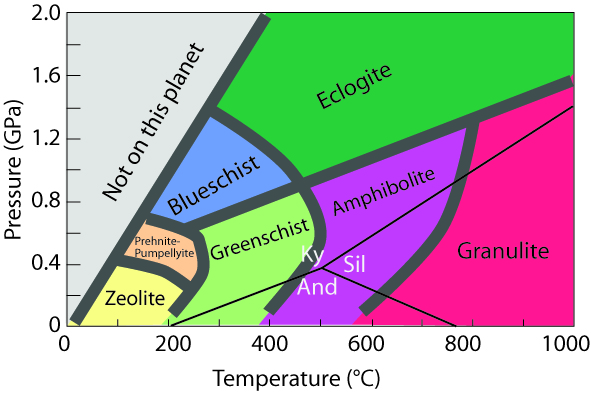
Thus, if we know the facies of metamorphic rocks in the region, we can determine what the geothermal gradient must have been like at the time the metamorphism occurred.
Metamorphic Textures
Metamorphic rocks exhibit a variety of textures. These can range from textures similar to the original protolith at low grades of metamorphism, to textures that are purely produced during metamorphism and leave the rock with little resemblance to the original protolith.Foliation is defined as a pervasive planar structure that results from the nearly parallel alignment of sheet silicate minerals and/or compositional and mineralogical layering in the rock. Most foliation is caused by the preferred orientation of phylosilicates, like clay minerals, micas, and chlorite. Preferred orientation develops as a result of non-hydrostatic or differential stress acting on the rock (also called deviatoric stress). We here review the differences between hydrostatic and differential stress.
Stress and Preferred Orientation
Pressure increases with depth of burial, thus, both pressure and temperature will vary with depth in the Earth. Pressure is defined as a force acting equally from all directions. It is a type of stress, called hydrostatic stress or uniform stress. If the stress is not equal from all directions, then the stress is called a differential stress. Normally geologists talk about stress as compressional stress. Thus if a differential stress is acting on the rock, the direction along which the maximum principal stress acts is called s1, the minimum principal stress is called s3, and the intermediate principal stress direction is called s2. Note that extensional stress would act along the direction of minimum principal stress.

If differential stress is present during metamorphism, it can have a profound effect on the texture of the rock.
Rounded grains can become flattened in the direction of maximum compressional stress.
Minerals that crystallize or grow in the differential stress field may develop a preferred orientation. Sheet silicates and minerals that have an elongated habit will grow with their sheets or direction of elongation orientated perpendicular to the direction of maximum stress.
This is because growth of such minerals is easier along directions parallel to sheets, or along the direction of elongation and thus will grow along s3 or s2, perpendicular to s1.
Since most phyllosilicates are aluminous minerals, aluminous (pelitic) rocks like shales, generally develop a foliation as the result of metamorphism in a differential stress field.
Example - metamorphism of a shale (made up initially of clay minerals and quartz)
Shales have fissility that is caused by the preferred orientation of clay minerals with their {001} planes orientated parallel to bedding. Metamorphic petrologists and structural geologists refer to the original bedding surface S0

Slate
Slates form at low metamorphic grade by the growth of fine grained chlorite and clay minerals. The preferred orientation of these sheet silicates causes the rock to easily break planes parallel to the sheet silicates, causing a slatey cleavage.<
ote that in the case shown here, the maximum principle stress is oriented at an angle to the original bedding planes so that the slatey cleavage develops at an angle to the original bedding. The foliation or surface produced by this deformation is referred to S1.

Schist
- The size of the mineral grains tends to enlarge with increasing grade of metamorphism. Eventually the rock develops a near planar foliation caused by the preferred orientation of sheet silicates (mainly biotite and muscovite). Quartz and feldspar grains, however show no preferred orientation. The irregular planar foliation at this stage is called schistosity
Gneiss
As metamorphic grade increases, the sheet silicates become unstable and dark colored minerals like hornblende and pyroxene start to grow.
These dark colored minerals tend to become segregated into distinct bands through the rock (this process is called metamorphic differentiation), giving the rock a gneissic banding. Because the dark colored minerals tend to form elongated crystals, rather than sheet- like crystals, they still have a preferred orientation with their long directions perpendicular to the maximum differential stress.

Granulite
- At the highest grades of metamorphism most of the hydrous minerals and sheet silicates become unstable and thus there are few minerals present that would show a preferred orientation. The resulting rock will have a granulitic texture that is similar to a phaneritic texture in igneous rocks.

In general, the grain size of metamorphic rocks tends to increase with increasing grade of metamorphism, as seen in the progression form fine grained shales to coarser (but still fine) grained slates, to coarser grained schists and gneisses.
Metamorphism and Deformation
Most regionally metamorphosed rocks (at least those that eventually get
exposed at the Earth's surface) are metamorphosed during deformational
events. Since deformation involves the application of differential
stress, the textures that develop in metamorphic rocks reflect the mode
of deformation, and foliations or slatey cleavage that develop during
metamorphism reflect the deformational mode and are part of the
deformational structures.
The deformation involved in the formation of fold-thrust mountain belts
generally involves compressional stresses. The result of compressional
stress acting on rocks that behave in a ductile manner (ductile behavior
is favored by higher temperature, higher confining stress [pressure] and
low strain rates) is the folding of rocks. Original bedding is
folded into a series of anticlines and synclines with fold axes
perpendicular to the direction of maximum compressional stress.
These folds can vary in their scale from centimeters to several
kilometers between hinges. Note that since the axial planes are
oriented perpendicular to the maximum compressional stress direction
that slatey cleavage or foliation should also develop along these
directions. Thus, slatey cleavage or foliation is often seen to
be parallel to the axial planes of folds, and is sometimes referred to
axial plane cleavage or foliation.

Metamorphic Differentiation
Gneisses, and to some extent schists, show compositional banding or
layering, usually evident as alternating somewhat discontinuous bands or
layers of dark colored ferromagnesian minerals and lighter colored
quartzo-feldspathic layers. The development of such compositional
layering or banding is referred to as metamorphic differentiation.
Throughout the history of metamorphic petrology, several mechanisms have
been proposed to explain metamorphic differentiation.
Preservation of Original Compositional Layering.
In some rocks the compositional layering may not represent
metamorphic differentiation at all, but instead could simply be the
result of original bedding. For example, during the early stages
of metamorphism and deformation of interbedded sandstones and shales the
compositional layering could be preserved even if the maximum
compressional stress direction were at angle to the original bedding.
In such a case, a foliation might develop in the shale layers due to the
recrystallization of clay minerals or the crystallization of other sheet
silicates with a preferred orientation controlled by the maximum stress
direction.

In such a case, it would be easy to determine that the compositional
layers represented original bedding because the foliation would cut
across the compositional layering.
In highly deformed rocks that have undergone both folding and shearing,
it may be more difficult to determine that the compositional layering
represents original bedding. As shearing stretches the bedding,
individual folded beds may be stretched out and broken to that the
original folds are not easily seen

Similarly, if the rock had been injected by dikes or sills prior to
metamorphism, these contrasting compositional bands, not necessarily
parallel to the original bedding, could be preserved in the metamorphic
rock.
Transposition of Original Bedding.
Original compositional layering a rock could also become transposed to a
new orientation during metamorphism. The diagram below shows how
this could occur. In the initial stages a new foliation begins to
develop in the rock as a result of compressional stress at some angle to
the original bedding. As the minerals that form this foliation
grow, they begin to break up the original beds into small pods. As
the pods are compressed and extended, partly by recrystallization, they
could eventually intersect again to form new compositional bands
parallel to the new foliation.

Solution and Re-precipitation.
In fine grained metamorphic rocks small scale folds, called kink bands,
often develop in the rock as the result of application of compressional
stress. A new foliation begins to develop along the axial planes of the
folds. Quartz and feldspar may dissolve as a result of pressure
solution and be reprecipitated at the hinges of the folds where the
pressure is lower. As the new foliation begins to align itself
perpendicular to s1, the end result would be alternating
bands of micas or sheet silicates and quartz or feldspar, with layering
parallel to the new foliation.

Preferential Nucleation.
Fluids present during metamorphism have the ability to dissolve minerals
and transport ions from one place in the rock to another.
Thus felsic minerals could be dissolved from one part of the rock and
preferentially nucleate and grow in another part of the rock to produce
discontinuous layers of alternating mafic and felsic compositions.

Migmatisation
As discussed previously, migmatites are small pods and lenses that occur
in high grade metamorphic terranes that may represent melts of the
surrounding metamorphic rocks. Injection of the these melts into
pods and layers in the rock could also produce the discontinuous banding
often seen in high grade metamorphic rocks. The process would be
similar to that described except that it would involve partially melting
the original rock to produce a felsic melt, which would then migrate and
crystallise in pods and layers in the metamorphic rock. Further
deformation of the rock could then stretch and fold such layers so that
they may no longer by recognizable as migmatites.
Metamorphic Minerals / Reactions
The mineral assemblages that occur in metamorphic rocks depend on four
factors:
- The bulk chemical composition of the original rock.
- The pressure reached during metamorphism.
- The temperature reached during metamorphism.
- The composition of any fluid phase that was present during
metamorphism.
If a rock is taken to some higher pressure and temperature then the mineral assemblage that develops should represent stable chemical equilibrium if the conditions are held for a long enough period of time that equilibrium can be achieved. Since metamorphism usually involves long periods of geologic time, most metamorphic rocks represent an equilibrium mineral assemblage.
Progressive / Prograde Metamorphism
Progressive or Prograde metamorphism occurs as the temperature and pressure are increased on the rock.As the pressure and temperature increase, a rock of a given chemical composition is expected to undergo a continuous series of chemical reactions between its constituent minerals and any fluid phase present to produce a series of new mineral assemblages that are stable at the higher pressures and temperatures.
Here is how the mineral assemblages might change in a hypothetical set of rocks, starting with a low grade mineral assemblage... then medium grade... then high grade...
- Low Grade Rocks - First, consider the compositions of various
types of rocks. Pelitic and quartzo-feldspathic rocks are
relatively aluminous, calcareous rocks are relatively rich in the C
component, and basic rocks are relative rich in the F component.At
some low temperature and pressure typical of low grade metamorphism,
pelitic and quartzo feldspathic rocks in this example would consist of
epidote, chlorite, andalusite, muscovite, and possibly quartz, k-spar,
muscovite, and albite.Calcareous rocks would contain epidote, calcite,
actinolite, and possibly quartz, albite, and k-spar. Basic rocks
would consist of epidote, chlorite, actinolite, and possibly, quartz,
albite, and k-spar. Ultramafic rocks would consist of actinolite,
chlorite and talc.

- Medium Grade Rocks - At some higher pressure and
temperature the assemblage might change as follows: pelitic
rocks would consist of sillimanite, plagioclase, cordierite,
muscovite, and possibly quartz and k-spar (the albite is now included
in the plagioclase). Quartzo-feldspathic rocks would consist of
plagioclase, cordierite, biotite, and likely quartz and k-spar.
Calcareous rocks would consist of grossularite, calcite and
hornblende. Basic rocks would contain plagioclase, biotite,
hornblende, and perhaps quartz and k-spar. Ultramafic rocks
would consist of biotite anthopyllite, and hornblende.

Now let's consider what happened in jumping from the pressure/ temperature conditions of the first diagram to those of the second diagram. First, we list the phases that have disappeared and those that have appeared:
Phases Disappeared
New Phases andalusite
sillimanite epidote/zoisite
plagioclase chlorite
grossularite talc
cordierite actinolite
biotite albite
anthophyllite
hornblende
Here are the chemical reactions that must have occurred between the two sets of pressure/temperature conditions that explain the new mineral assemblages...For the disappearance of andalusite and appearance of sillimanite the reaction is simple:
Al2SiO5 => Al2SiO5
Epidote (zoisite) would break down to produce the anorthite component of plagioclase and grossularite, resulting in the expulsion of water as a fluid phase:
Andalusite Sillimanite
4Ca2Al3Si3O12(OH) + SiO2 => 5CaAl2Si2O8 + Ca3Al2Si3O12 + 4H2O
Chlorite could have reacted with muscovite and quartz to produce biotite, cordierite, and fluid:
Epidote/Zoisite Qtz Anorthite (plag) grossularite fluid
(Mg,Fe)5Al2Si3O10(OH)2 + KAl3Si3O10(OH)2 + 2SiO2 =>
K(Fe,Mg)3AlSi3O10(OH)2 + (Mg,Fe)2Al4Si5O18 +4H2O
Chlorite Muscovite Qtz
Biotite Cordierite fluid
Talc would break down to produce anthophyllite, quartz, and fluid:
and chlorite, actinolite, epidote (zoisite), and quartz would react to produce hornblende and fluid:7Mg3Si4O10(OH)8 => 3Mg7Si8O22(OH)2 + 4SiO2 + 4H2O
Talc Anthophyllite Qtz fluid7(Mg,Fe)5Al2Si3O10(OH)2+13Ca2(Mg,Fe)5Si8O22(OH)2+12Ca2Al3Si3O12(OH)+14SiO2 =>
Chlorite Actinolite epidote (Zoisite) Qtz
25Ca2(Mg,Fe)4Al2Si7O22 (OH)2 + 22H2O
Hornblende fluid
With the exception of the first reaction (andalusite => sillimanite) all of these reactions result in the evolution of H2O in a fluid phase. Such reactions are called dehydration reactions. - High Grade Rocks - Next, increase the temperature and
pressure so that a new set of minerals develops for each rock.
At these new pressure/temperature conditions, pelitic rocks would contain plagioclase, sillimanite, cordierite, quartz, and k-spar.Quartzo-feldspathic rocks would consist of plagioclase, cordierite, almandine/pyrope garnet, quartz, and k-spar. Calcareous rocks would consist either of wollastonite, grossularite and diopside, or grossularite, plagioclase, and diopside, or plagioclase, diopside, and biotite, depending on the composition of the initial rock.Basic rocks would consist of plagioclase, diopside, and almandine/pyrope, or plagioclase, hypersthene, and almandine/pyrope.Ultramafic rocks would consist of hypersthene, almandine/pyrope, and diopside.

A list of the phases that disappeared and those that appeared at some point between the two pressure/temperature conditions include...
| Phases Disappeared | |
New Phases |
|---|---|---|
| muscovite | wollastonite | |
| calcite | diopside | |
| hornblende | hypersthene | |
| anthophyllite | almandine/pyrope | |
| biotite | hypersthene and k-spar |
Here are the chemical reactions that must have occurred between the two sets of pressure/temperature conditions that explain the new mineral assemblages...
For the disappearance of muscovite:
KAl3Si3O10(OH)2 + SiO2 => KAlSi3O8 + Al2SiO5 + H2OFor the disappearance of calcite and the appearance of wollastonite:
Muscovite Qtz K-spar Sillimanite fluid
CaCO3 + SiO2 => CaSiO3 + CO2Hornblende break down to diopside, hypersthene,plagioclase, and fluid:
Calcite Qtz Wollastonite fluid
Anthophyllite would break down to hypersthene and quartz:Ca2Mg4Al2Si7O22 (OH)2 => CaMgSi2O6 + 3MgSiO3 + CaAl2Si2O8 +H2O
Hornblende Diopside Hypersthene Plagioclase fluid
Mg7Si8O22(OH)2 => 7MgSiO3 + SiO2 + H2OFor the breakdown of biotite to form hypersthene and k-spar the following reaction must have occurred:
Anthophyllite Hypersthene Qtz fluid
K(Fe,Mg)3AlSi3O10(OH)2 + 3SiO2 => KAlSi3O8 + 3(Mg,Fe)SiO3 + H2OFor the formation of almandine/pyrope from cordierite and anthophyllite:
Biotite Qtz K-spar Hypersthene fluid
(Mg,Fe)2Al4Si5O18 + (Mg,Fe)7Si8O22(OH)2 =>2(Mg,Fe)3Al2Si3O12 + 3(Mg,Fe)SiO3 + 4SiO2 + H2O
Cordierite Anthophyllite
Almandine/Pyrope Hypersthene Qtz fluid
\All of the reactions evolve a fluid phase. The calcite => wollastonite reaction is a decarbonation reaction, and the rest are dehydration reactions. This illustrates very well the concept we have discussed repeatedly throughout this course, that prograde metamorphism involves a series of devolatilization reactions that produce a fluid phase. The fluid phase generally will consist of a mixture of H2O and CO2. This results in producing minerals that are less volatile rich with increasing grade of metamorphism. Ultimately, at the highest grade of metamorphism no hydrous or carbonate bearing phases exist.
Retrograde Metamorphism
If retrograde metamorphism were a common process then upon uplift and unroofing metamorphic rocks would progressively return to mineral assemblages stable at lower pressures and temperatures. Yet, high grade metamorphic rocks are common at the surface of the Earth and usually show only minor retrograde minerals.
Three factors inhibit retrograde metamorphism, two of which involve the fluid phase...
- Chemical reactions run faster at higher temperatures.
During prograde metamorphism the reaction boundaries are continually
being over-stepped to higher temperature. At higher temperature
diffusion rates are higher and molecular vibration required to break
chemical bonds is higher. Thus, during prograde metamorphism
reaction rates are faster. As temperature is lowered on a rock,
the reaction boundaries are over-stepped to low temperature, and as a
result the reaction rates are much slower.
Of course, this depends on the rate at which temperature is lowered. It is certainly possible for temperatures to decrease at such a slow rate during uplift and unroofing, that retrograde mineral assemblages would have time to form. Also, a second episode of prograde metamorphism may occur during which temperatures are increased again. Minerals stable at the new temperature may start to grow and overprint the minerals that were formed at higher temperature during the first episode of metamorphism. - A fluid phase is driven off as a result of the devolatilization reactions, during prograde metamorphism, As pressure increases, porosity of rocks also decreases, and thus this fluid phase will likely be driven out of the rock body. In the absence of the fluid phase it is impossible to form hydrous minerals and carbonates, since H2O and CO2, two of the key components needed in such reactions, may not be present.
- The fluid phase also helps to catalyze chemical reactions. Although the net reactions may appear to be solid-solid reactions, in reality there may be more involved. For example the fluid phase could dissolve a mineral in one part of the rock and precipitate a new mineral in another part of the rock, just as happens during diagenesis of sedimentary rocks. If the fluid phase is driven off during prograde metamorphism, then it will not be available to catalyze the reactions to produce the retrograde mineral assemblage as pressure and temperature are lowered.

